To sign up to receive the latest Canadian Energy Centre research to your inbox email research@canadianenergycentre.ca
The wealth of oil and gas workers: Interprovincial employees in Alberta’s oil and gas industry and their contribution to the Canadian economy
Over the past two decades, Alberta has been a magnet for job seekers across Canada, even during downturns in the provincial economy, according to an analysis by the Canadian Energy Centre.
This has resulted in increased labour income and broader economic activity as employees earn income in Alberta but send and bring money back to their home provinces, including paying income and other taxes.
Highlights from the Fact Sheet include:
- As of 2016, Alberta had the highest proportion of interprovincial employees of any province, at 2.3 per cent The number of interprovincial employees in Alberta grew by nearly 57 per cent between 2002 and 2016, compared to 18 per cent in Ontario.
- The largest proportion of interprovincial employees in Alberta in 2016 were from British Columbia (37 per cent), followed by Atlantic Canada (20 per cent), Saskatchewan (17 per cent) and Ontario (17 per cent).
- The number of interprovincial employees working in Alberta’s oil and gas sector grew by more than 156 per cent between 2002 and 2016. In 2016 there were a total of 12,645 interprovincial employees working in the oil and gas extraction and support activities in Alberta.
- In 2016, interprovincial employees in Alberta’s oil and gas sector earned an average income of $77,091, which is among the highest of all industries.
- Income earned by interprovincial employees in Alberta’s oil and gas sector grew nearly 455 per cent between 2002 and 2016. Cumulative income of these employees filing income tax returns in other provinces but based in Alberta during that time period amounted to more than $12.1 billion.
Overview: Interprovincial employees and their home-province benefits
The expansion of Canada’s oil and gas sector over the past two decades and the spin-off effects it has on broader economic activity have made Alberta a magnet for job seekers across Canada. The result is increased labour income for many Canadians. This is meaningful because such job seekers earn income in Alberta but send and bring money back to their home provinces, where they also pay income and other taxes. This has been the case even during downturns in the Alberta economy.
Understanding IPEs
The oil and gas sector employs Canadians from across the country, many who use their income to benefit the economies of the provinces in which they permanently reside. One such group of employees are Canadians who commute to work in Alberta but maintain their primary residence elsewhere, known as interprovincial employees (IPEs). Individuals are identified as IPEs if they receive T4 earnings or income in a province (such as Alberta) during a given year, but report that they reside in another province on their T1 tax returns.
This Fact Sheet (which can be downloaded here as a pdf) examines the contribution of IPEs in Alberta’s oil and gas sector to other provinces. To do so, we examine IPE trends between 2002 and 2016 (the earliest and latest years for which data is available) using time series data from the Statistics Canada Canadian Employer-Employee Dynamics Database (CEEDD). The time lag is due to the multiple years of historical tax filer data required to accurately identify IPEs.
Alberta is a prime destination for IPEs
The total number of IPEs in Alberta increased from 61,395 in 2002 to 146,530 in 2014, before falling back to 96,215 in 2016, likely the result of the decline in energy prices and activity.
However, even with the energy price decline, the number of IPEs working in Alberta still grew by nearly 57 per cent between 2002 and 2016. In contrast, the growth in IPEs in Ontario was 18 per cent. Of note, the growth of IPEs in two other major oil and gas provinces, Saskatchewan and Newfoundland & Labrador, amounted to 54 per cent and 85 per cent respectively.
Over the period surveyed, Ontario has consistently had the most inter-provincial employees residing in-province (see Figure 1a), with 124,130 in 2002 and 147,090 in 2016. The large absolute numbers are to be expected given Ontario has the largest population among the provinces.
IPEs as a percentage of the total population
To gain a clearer understanding of how critical IPEs are to provinces outside Alberta, we have calculated IPEs as a percentage of each province’s population. In most years, IPEs in Alberta constituted a higher proportion of the total population than IPEs in other provinces.
- In 2014, the percentage of the Alberta workforce that declared another province as home was 3.6 per cent, compared with 1.1 per cent in British Columbia, 1 per cent in Ontario and 0.6 per cent in Quebec.
- In 2016, the proportion of Alberta employees who declared another province as their home declined to 2.3 per cent, but that was still significantly higher than other highly populated provinces such as British Columbia (1.1 per cent), Ontario (1.1 per cent) and Quebec (0.7 per cent) and also higher than all other provinces.
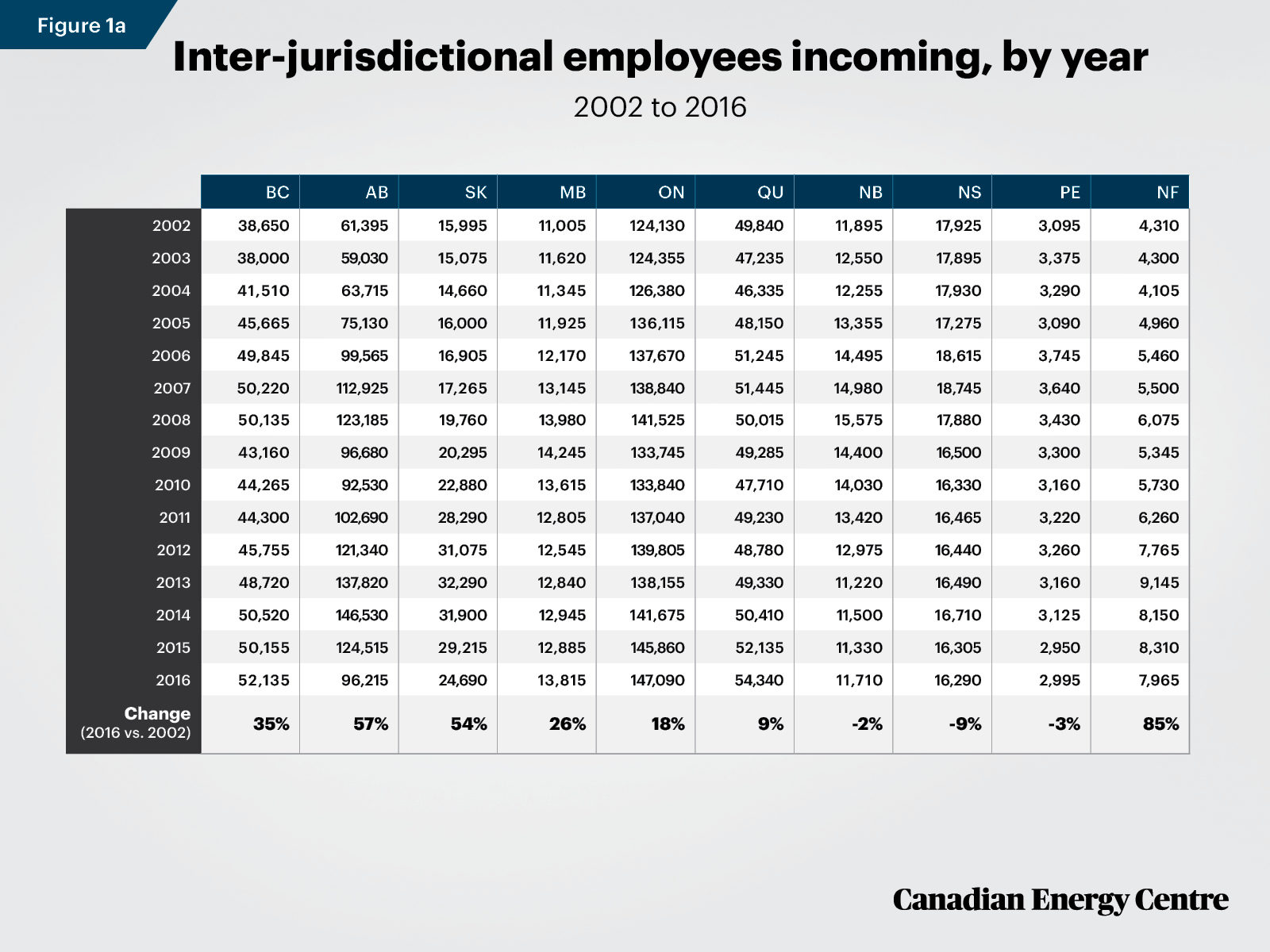
Source: Derived from Statistics Canada, Canadian Employer-Employee Dynamics Database.
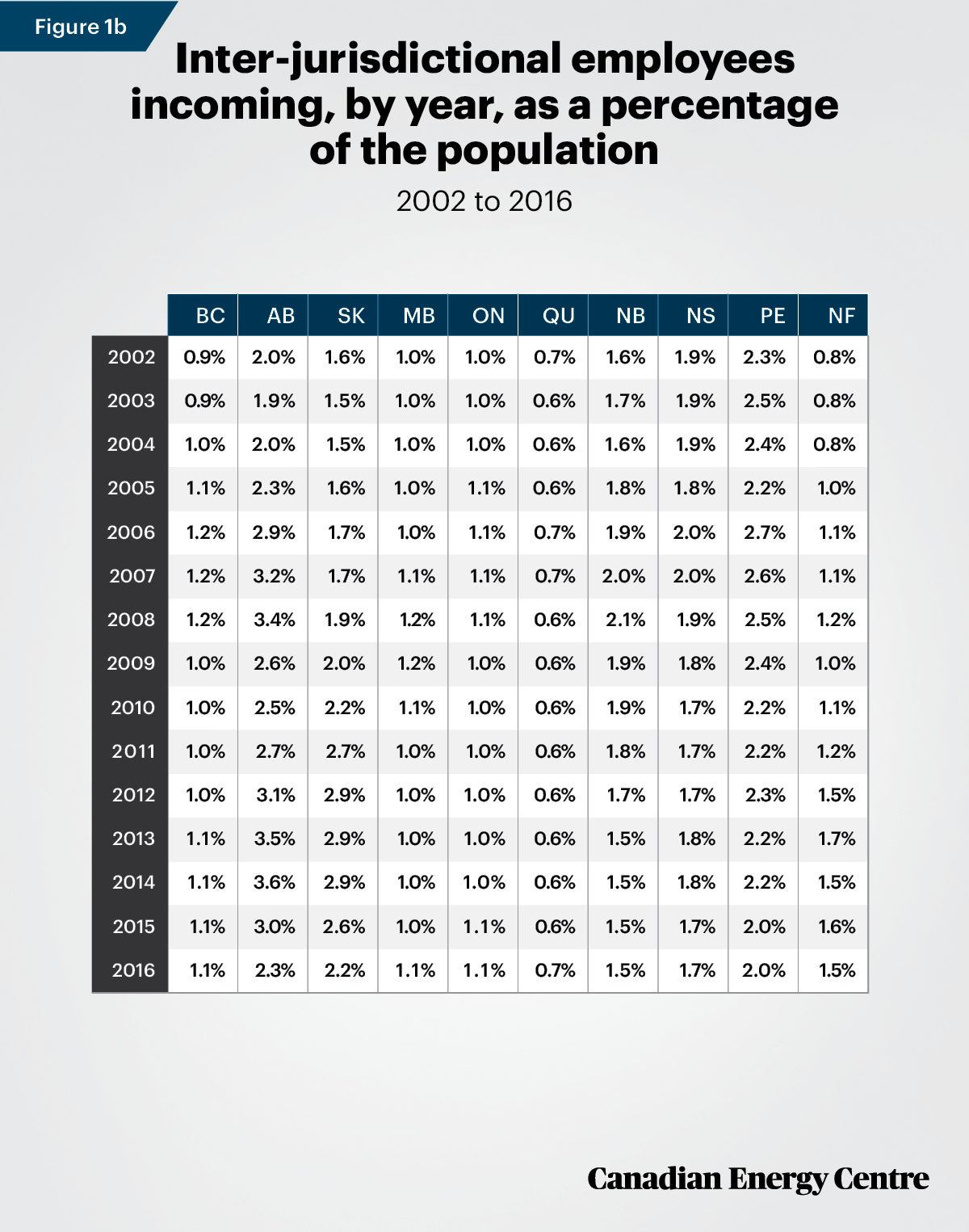
Source: Derived from Statistics Canada, Canadian Employer-Employee Dynamics Database.
Where Alberta’s IPEs come from
While IPEs come to Alberta from across Canada, the primary sources in 2016 were B.C. (37 per cent), Atlantic Canada (20 per cent), Saskatchewan (17 per cent) and Ontario (17 per cent).
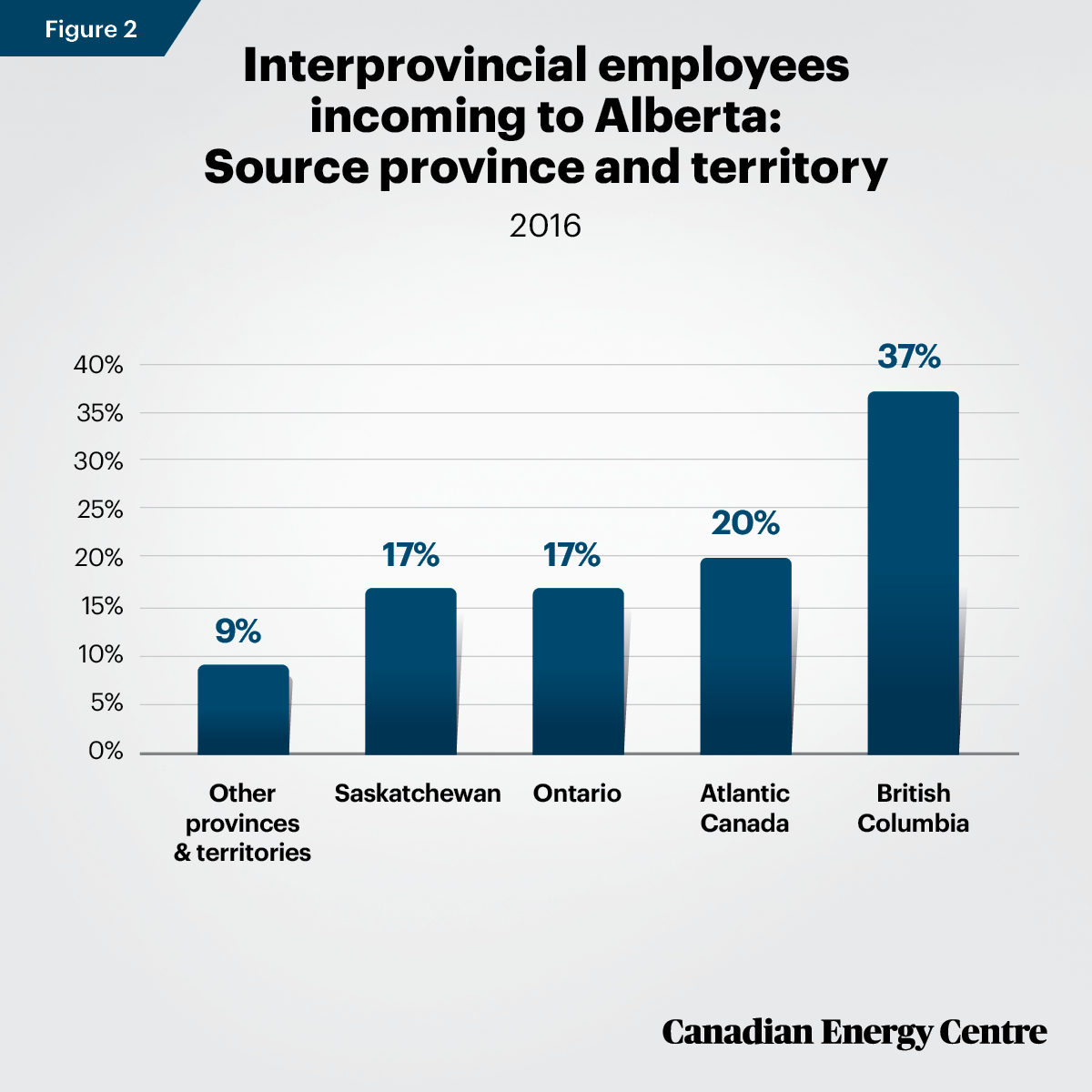
Source: Derived from Statistics Canada, Canadian Employer-Employee Dynamics Database.
The Alberta money flow in 2016: $4.4 billion earned by IPEs
Income¹ earned by IPEs in Alberta increased from $1.2 billion in 2002 to $7.6 billion in 2014 before falling back to $4.4 billion in 2016. Even with the energy price decline, income earned by IPEs in Alberta grew by nearly 267 per cent between 2002 and 2016 (see figure 3).
1. In constant 2016 dollars.
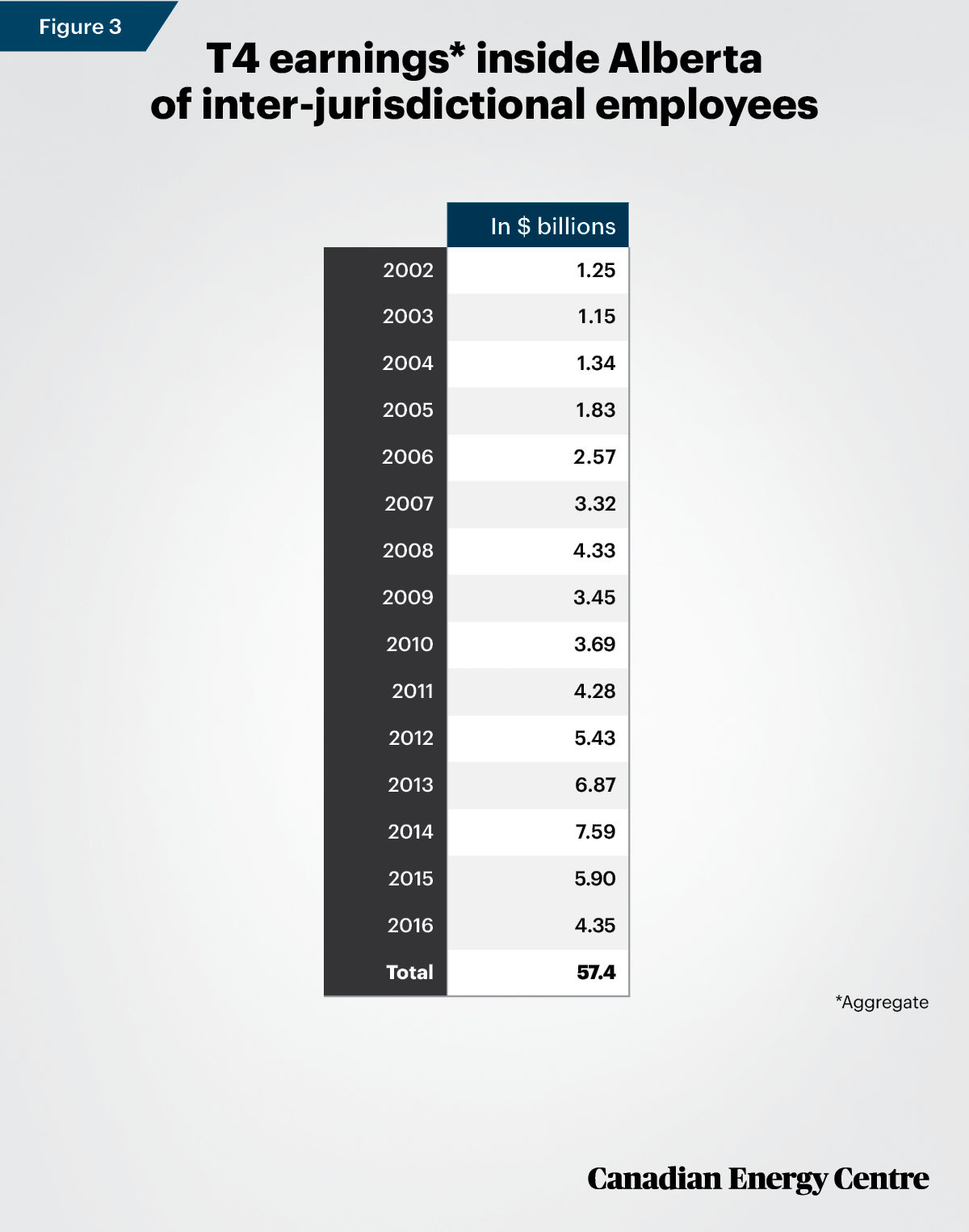
Source: Derived from Statistics Canada, Canadian Employer-Employee Dynamics Database.
Some of the earnings from IPEs go back to the local economies in which these employees permanently reside in the form of consumption of goods and services, and ultimately federal and provincial taxes. Of the nearly $4.4 billion earned by IPEs in Alberta during 2016:
- Nearly 41 per cent was earned by B.C. residents;
- 22 per cent by residents of the Atlantic provinces;
- 16 per cent by residents of Saskatchewan;
- 15 per cent by residents of Ontario; and
- 6 per cent in the other provinces and the territories.
The Alberta money flow 2002 to 2016: Over $57 billion to IPEs, with British Columbians being the biggest beneficiaries
In total, IPEs residing in Alberta earned $57.4 billion between 2002 and 2016, an average of over $3.8 billion per year. Of this total, $19.5 billion or 34 per cent was earned by B.C. residents, $14.6 billion or 25 per cent by Atlantic residents, $8.3 billion of 15 per cent by Ontario residents, and even $1.9 billion or 3 per cent by Quebec residents. Another $13 billion or 23 per cent flowed to IPEs who reside in the other provinces and the territories.
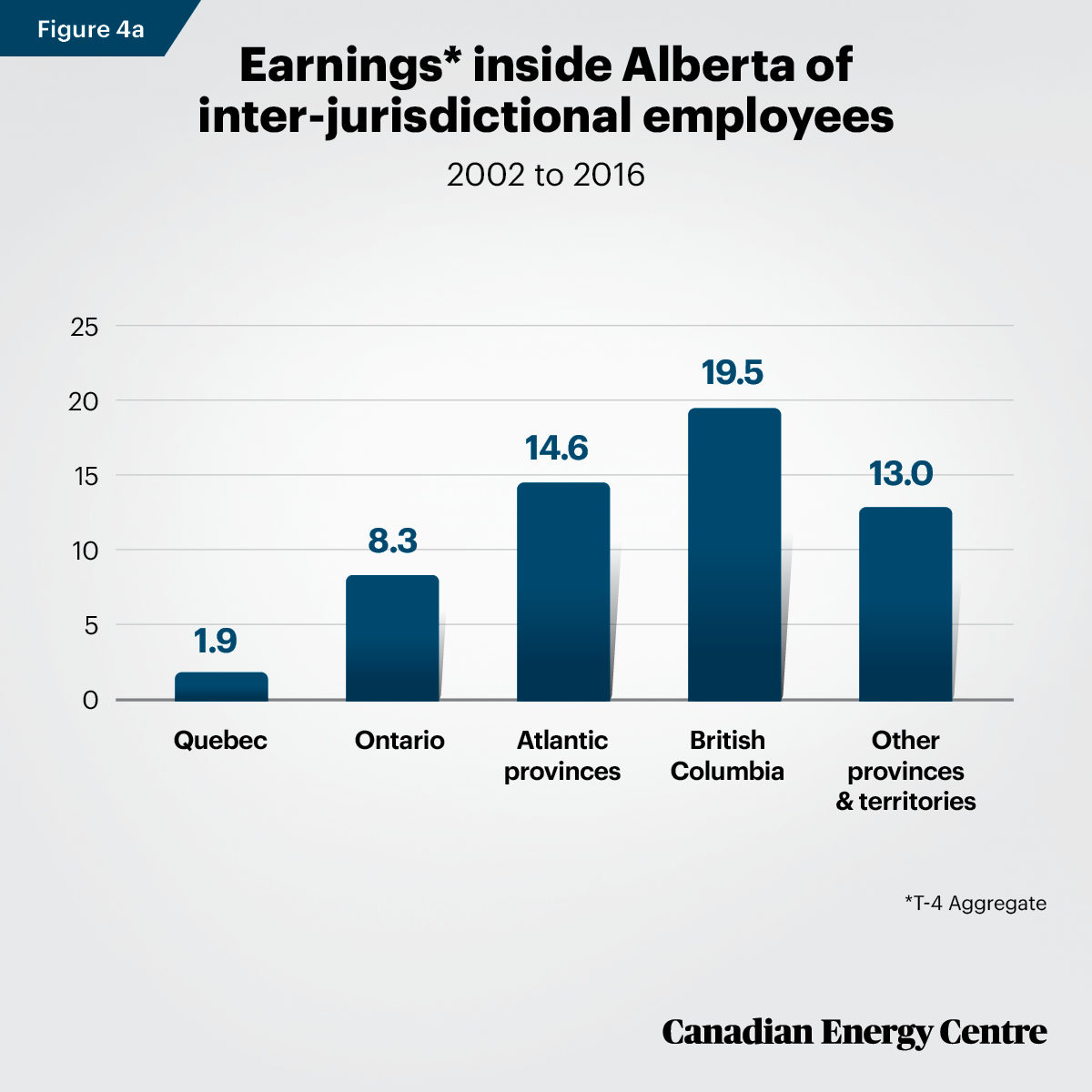
Source: Derived from Statistics Canada, Canadian Employer-Employee Dynamics Database.
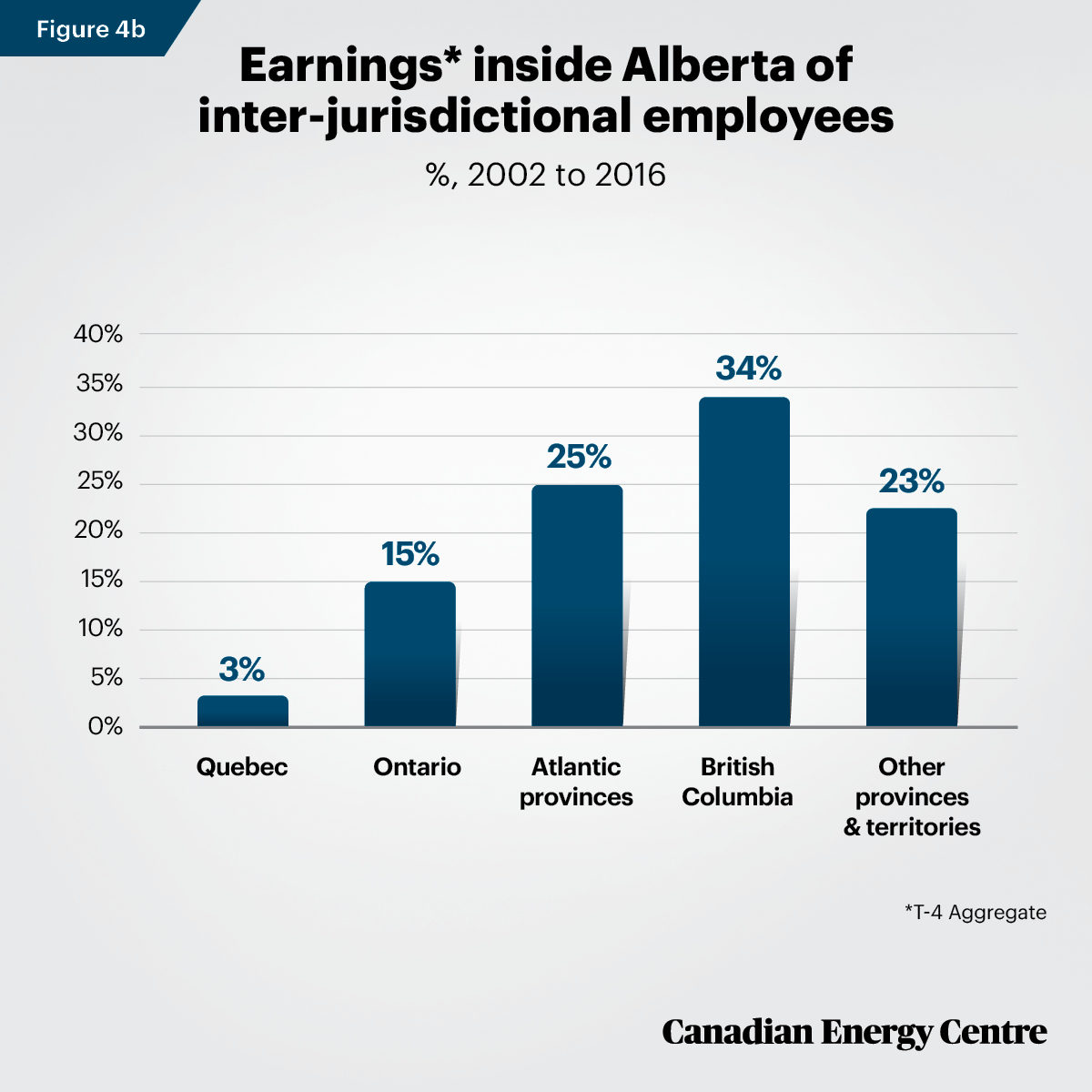
Source: Derived from Statistics Canada, Canadian Employer-Employee Dynamics Database.
Oil and gas sector employment income for IPEs: Over $12 billion
IPE employment in the oil and gas extraction and support activities sector in Alberta grew from 4,935 in 2002 to 19,980 in 2014, before falling back to 12,645 in 2016. Even so, the number of IPEs working in Alberta’s oil and gas sector increased by over 156 per cent between 2002 and 2016.
As the number of IPEs employed in Alberta’s oil and gas sector has grown, so has the total income earned by those employed in the sector in Alberta.
- Between 2002 and 2016, income grew from $175.8 million to over $1.5 billion in 2014, before falling back to $975 million in 2016.
- Even so, the income earned by oil and gas sector IPEs grew by nearly 455 per cent between 2002 and 2016.
- In fact, between 2002 to 2016 inclusive, IPEs in Alberta employed in oil and gas earned over $12.1 billion in cumulative income.
The importance of the oil and gas sector to the income earned by IPEs cannot be overstated. Employment in the oil and gas sector for IPEs in Alberta is financially rewarding. In 2016, IPEs employed in the oil and gas sector in Alberta earned an average income of $77,091. This is among the highest of all industries in which IPEs are employed in the province including professional, scientific and technical services ($50,176) and utilities ($76,970).
While IPEs working in the oil and gas sector comprised about 13 per cent of total IPEs in Alberta, their income comprised over 22 per cent of total income earned by IPEs in the province during 2016 (see figure 5).
This further reflects the fact that oil and gas is a high-paying industry for all Canadians, including IPEs. It is important to note that the average earnings reported are not the total individual annual income earned by IPEs, just the amount that was earned while working in Alberta.
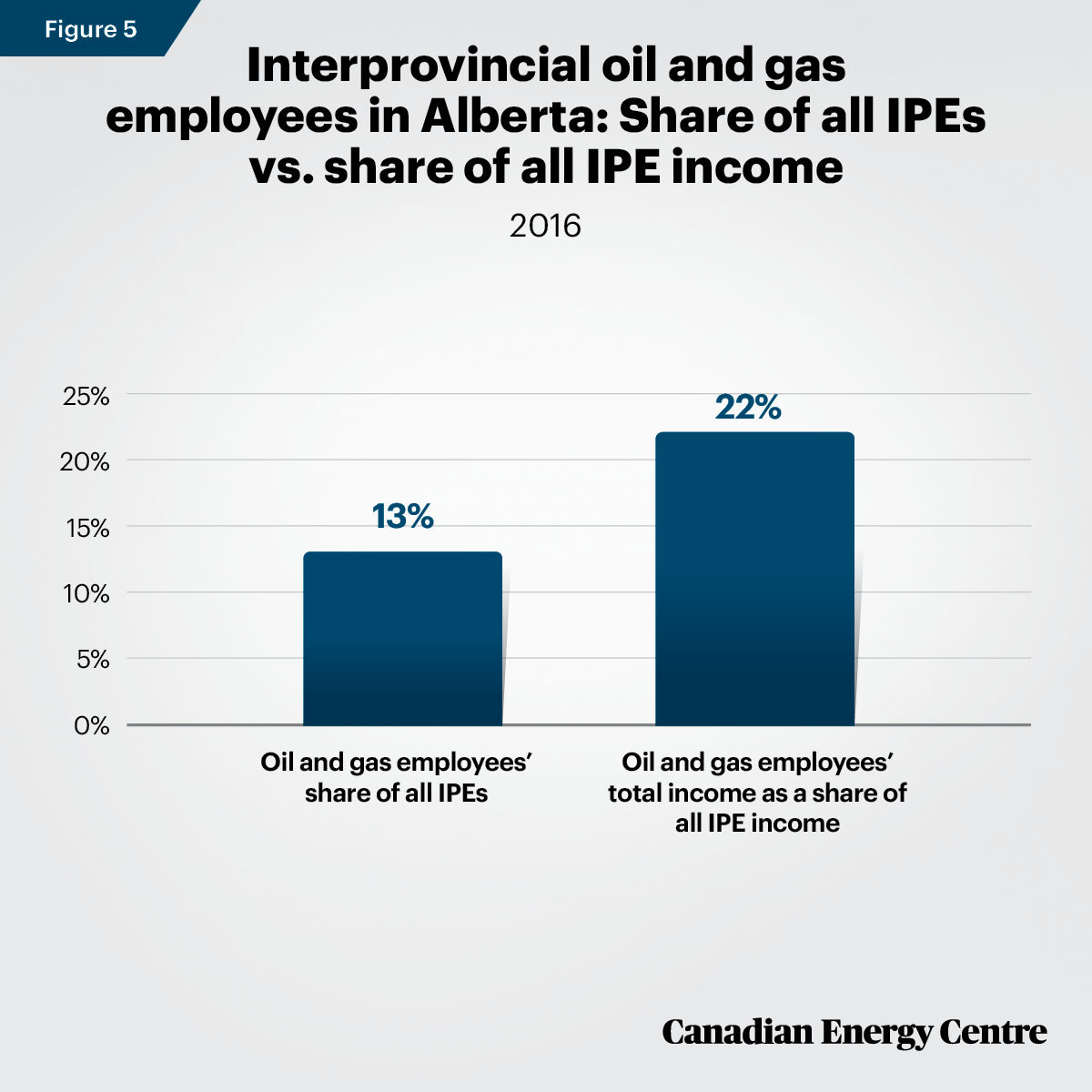
Source: Derived from Statistics Canada, Canadian Employer-Employee Dynamics Database.
Oil and gas sector income for Alberta’s interprovincial employees: Second only to construction sector
The income earned by IPEs in Alberta in the oil and gas sector was $12.1 billion, second only to construction at $19.8 billion, between 2002 and 2016 in total. Of note, the oil and gas sector in Alberta has significant spin-off effects on the construction sector, particularly as it relates to construction of oil sands projects.
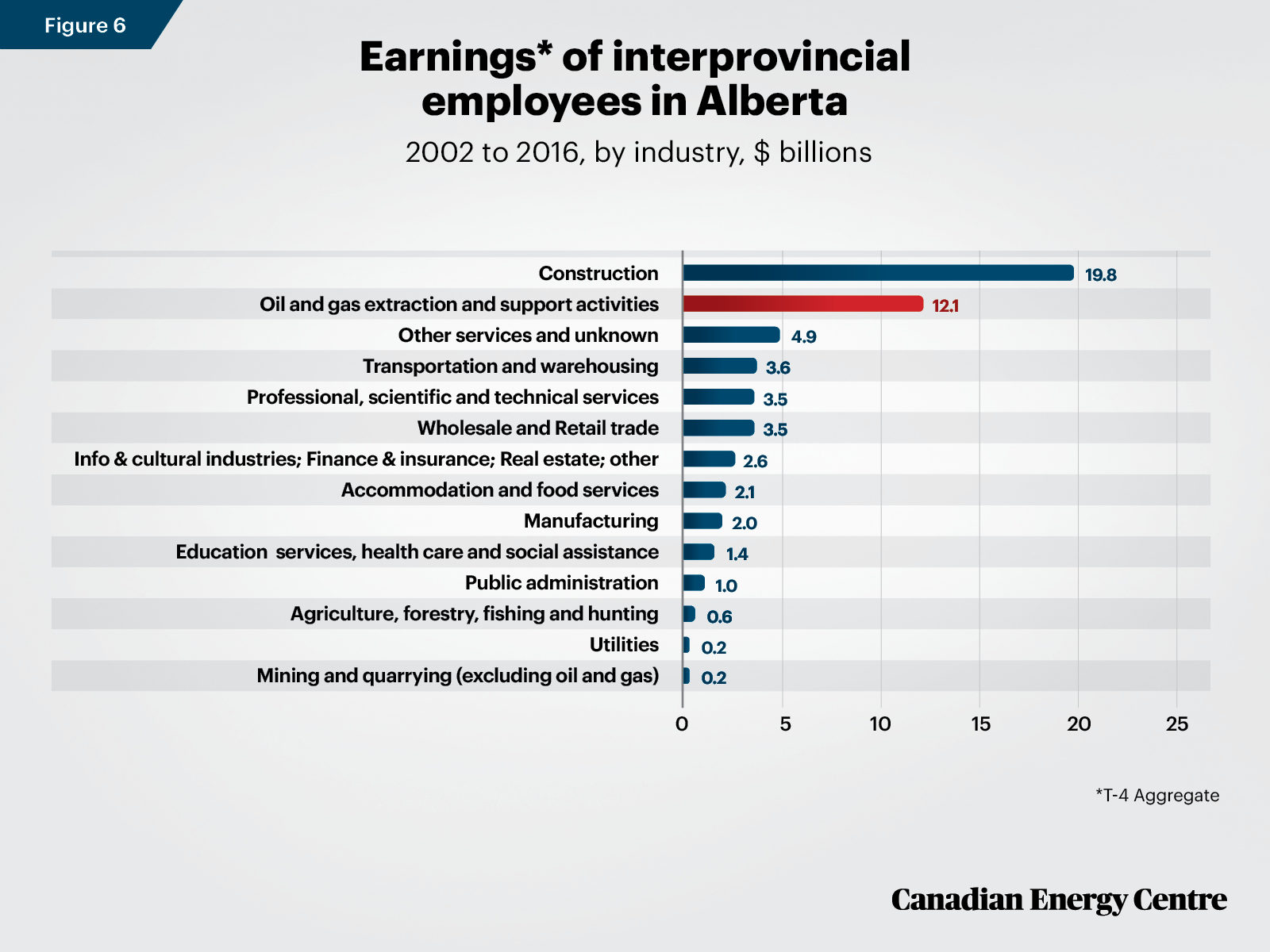
Source: Derived from Statistics Canada, Canadian Employer-Employee Dynamics Database.
Takeaway
Clearly, IPEs from across Canada have been attracted to Alberta due to the prospects for high-paying jobs in the oil and gas sector.
- The number of IPEs in Alberta increased by nearly 57 per cent between 2002 and 2016, while the growth in IPEs in Ontario was just 18 per cent in comparison.
- In 2016, the proportion of Alberta employees classified as IPEs was 2.3 per cent, significantly higher than other highly populated provinces such as British Columbia (1.1 per cent), Ontario (1.1 per cent) and Quebec (0.7 per cent), and higher than all other provinces.
- IPE employment in the oil and gas extraction and support activities sector in Alberta increased by over 156 per cent between 2002 and 2016.
- As the number of IPEs employed in Alberta’s oil and gas sector has grown, so has their total income earned. Income earned by oil and gas sector IPEs in Alberta grew by nearly 455 per cent between 2002 and 2016.
- Overall, from 2002 to 2016, IPEs in Alberta employed in oil and gas earned over $12.1 billion in cumulative income.
The decision by IPEs to travel to Alberta for work in the oil and gas sector is another example of the economic benefits that Canada’s oil and gas sector brings to all Canadians, regardless of province of residence.
Notes:
Terms and definitions used in this report related to employment and incomes can be accessed through Statistics Canada. This CEC Fact Sheet was compiled by Lennie Kaplan and Mark Milke at the Canadian Energy Centre: www.canadianenergycentre.ca. The authors and the Canadian Energy Centre would like to thank and acknowledge the assistance of Philip Cross in reviewing the data and research for this Fact Sheet. Image credits: ‘Workers sitting in locker room” by Hybrid Images on Getty Images.
Sources: (All links live as of August 11, 2020)
Government of Alberta (2017), Demographic Spotlight Interprovincial Employees in Alberta: Industrial Profile by Major Region of Origin <https://bit.ly/33OJE5Z>; Government of Canada (2015), Interprovincial Employment in Canada, 2002 to 2011 <https://bit.ly/3ioW8Fs>; MDPI (2020), Dependence on Interprovincial Migrant Labour in Atlantic Canadian Communities: The Role of the Alberta Economy <https://bit.ly/33PnmRv>; Statistics Canada (2020), Canadian Employer-Employee Dynamics Database <https://bit.ly/2DC8kUG>.
Creative Commons Copyright
Research and data from the Canadian Energy Centre (CEC) is available for public usage under creative commons copyright terms with attribution to the CEC. Attribution and specific restrictions on usage including non-commercial use only and no changes to material should follow guidelines enunciated by Creative Commons here: Attribution-NonCommercial-NoDerivs CC BY-NC-ND.
